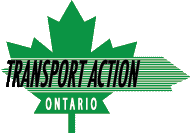Given that transportation in Canada is responsible for approximately 34 per cent of our carbon emissions it’s interesting to note how the media and two levels of senior government have tended to ignore it. Add the fact that carbon-intensive air transportation is ring-fenced due to its exemption from the COP21 Paris climate-change aspirations and one must wonder what actions will be taken on the ground to compensate.
So far, it seems there’s lots of excitement about electric cars and ride sharing but very little beyond this. Outside the GTHA the private motor coach industry wrings what profitability it can from a shrinking route network. Only in September 2015 did the province of Ontario invite public submissions on a new regulatory framework for bus operations. Whether buses can be restored as an appealing option of carbon-efficient transport for rural and intercity passengers remains to be seen.
Trucking has had very little mention in climate change discussions. The ability to haul dual 53-foot trailers behind a single tractor as a productivity boost has been in place for several years but one has to answer the philosophical question of whether a train belongs on the highway or the rails. Future ton/mile emission reductions will be increasingly hard to find as highway congestion worsens.
Canada’s woeful underinvestment in intercity passenger rail for the past 50 years or so beggars the belief of most of our G7 partners except, perhaps, the United States. But the voice of opposition in many U.S. states is changing to a more positive approach as communities push politicians for rail service reinstatements and expansion. The diminishing utility of the personal automobile for longer trips and increasing hassles of flying are being supplemented by greater concern about the environment and this is where the passenger train is seen as a more attractive and sustainable option.
Much the same applies in Canada where communities with existing passenger train service are starting to understand their value in a congested and carbon-constrained world. Bus feeder service to nearest railway stations is also receiving growing attention and rural public transportation advocacy is becoming focused and louder as personal hardship levels grow when the private automobile is no longer a mobility option.
While paper-progress is being made on the federal- and provincial-level plans for intercity passenger rail expansion, it is quite obvious that they are totally incompatible. On one hand, VIA Rail wants a new, freight-free route between Montreal and Toronto with higher frequency trains operating at about 175 km/h, whereas the province of Ontario is planning a true high-speed rail investment in the southwest with 320-km/h capability. A real head-scratcher!
VIA’s position has somewhat more economic and technical credibility than Ontario’s but neither seems to recognize that much of their ridership comes from intermediate stops along existing corridor routes. Communities such as Sarnia, Stratford, Woodstock, Ingersoll, Brantford, and Chatham are voicing concern that they could actually lose intercity passenger rail service under the current federal and provincial rail infrastructure plans. Neither level of government has yet provided them with any clarity whatsoever.
One solution, largely dismissed by governments, is the upgrade of existing rail infrastructure on current Montreal-to-Windsor corridor service to permit 175-km/h operation and more intensive schedules. Given that government relationships with both CN and CP have been challenged for several decades, any pursuit of this concept will not be for the faint of heart. But it’s precisely what Amtrak does in the U.S. to get more passenger trains onto existing privately owned rails.
If mutual accommodation can be found between CN, CP, and our two senior levels of government, an injection of public money could benefit all parties. In addition to accommodating more and faster passenger trains it could also be used to remove freight bottlenecks including construction of the “missing link” between the Milton GO rail line and the CN bypass line at Bramalea, west of Toronto. It would make passenger rail plans easier to achieve and speed freight movements across the top of the GTHA.
This and similar capacity improvements along the existing corridor rights-of-way could be implemented more quickly and at far less cost than VIA’s proposed new route and the provincial high-speed rail plans combined. The resulting speed increases with the high-performance solution would deliver the train frequencies, fares and journey times people want, while substantially reducing carbon emissions.
Under new climate-change realities, a public-private mechanism must be found for preserving Canadian rail infrastructure and making it more productive. Railways built Canada and are now, more than ever, a means to sustain it as we seek ways of reducing our carbon footprint while offering the public safe, economical and reliable mobility.
When economic and climate-change realities are stark it’s better to look at more immediate, astute and affordable improvements to passenger rail services. Grander plans can wait for better times.


